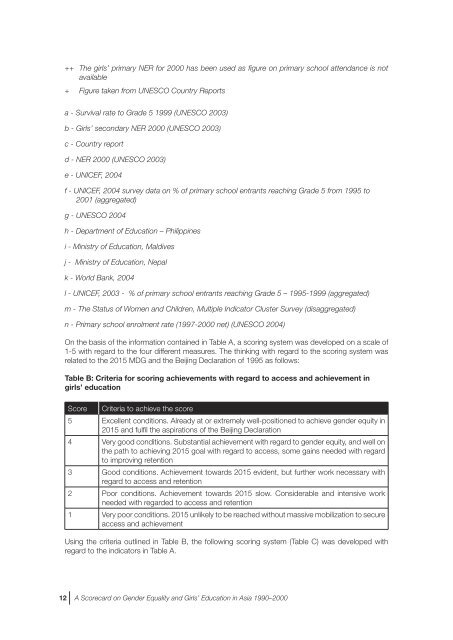A Scorecard on gender equality and girls ... - unesdoc - Unesco
A Scorecard on gender equality and girls ... - unesdoc - Unesco
A Scorecard on gender equality and girls ... - unesdoc - Unesco
Create successful ePaper yourself
Turn your PDF publications into a flip-book with our unique Google optimized e-Paper software.
++ The <strong>girls</strong>’ primary NER for 2000 has been used as figure <strong>on</strong> primary school attendance is not<br />
available<br />
+ Figure taken from UNESCO Country Reports<br />
a - Survival rate to Grade 5 1999 (UNESCO 2003)<br />
b - Girls’ sec<strong>on</strong>dary NER 2000 (UNESCO 2003)<br />
c - Country report<br />
d - NER 2000 (UNESCO 2003)<br />
e - UNICEF, 2004<br />
f - UNICEF, 2004 survey data <strong>on</strong> % of primary school entrants reaching Grade 5 from 1995 to<br />
2001 (aggregated)<br />
g - UNESCO 2004<br />
h - Department of Educati<strong>on</strong> – Philippines<br />
i - Ministry of Educati<strong>on</strong>, Maldives<br />
j - Ministry of Educati<strong>on</strong>, Nepal<br />
k - World Bank, 2004<br />
l - UNICEF, 2003 - % of primary school entrants reaching Grade 5 – 1995-1999 (aggregated)<br />
m - The Status of Women <strong>and</strong> Children, Multiple Indicator Cluster Survey (disaggregated)<br />
n - Primary school enrolment rate (1997-2000 net) (UNESCO 2004)<br />
On the basis of the informati<strong>on</strong> c<strong>on</strong>tained in Table A, a scoring system was developed <strong>on</strong> a scale of<br />
1-5 with regard to the four different measures. The thinking with regard to the scoring system was<br />
related to the 2015 MDG <strong>and</strong> the Beijing Declarati<strong>on</strong> of 1995 as follows:<br />
Table B: Criteria for scoring achievements with regard to access <strong>and</strong> achievement in<br />
<strong>girls</strong>’ educati<strong>on</strong><br />
Score<br />
Criteria to achieve the score<br />
5 Excellent c<strong>on</strong>diti<strong>on</strong>s. Already at or extremely well-positi<strong>on</strong>ed to achieve <strong>gender</strong> equity in<br />
2015 <strong>and</strong> fulfil the aspirati<strong>on</strong>s of the Beijing Declarati<strong>on</strong><br />
4 Very good c<strong>on</strong>diti<strong>on</strong>s. Substantial achievement with regard to <strong>gender</strong> equity, <strong>and</strong> well <strong>on</strong><br />
the path to achieving 2015 goal with regard to access, some gains needed with regard<br />
to improving retenti<strong>on</strong><br />
3 Good c<strong>on</strong>diti<strong>on</strong>s. Achievement towards 2015 evident, but further work necessary with<br />
regard to access <strong>and</strong> retenti<strong>on</strong><br />
2 Poor c<strong>on</strong>diti<strong>on</strong>s. Achievement towards 2015 slow. C<strong>on</strong>siderable <strong>and</strong> intensive work<br />
needed with regarded to access <strong>and</strong> retenti<strong>on</strong><br />
1 Very poor c<strong>on</strong>diti<strong>on</strong>s. 2015 unlikely to be reached without massive mobilizati<strong>on</strong> to secure<br />
access <strong>and</strong> achievement<br />
Using the criteria outlined in Table B, the following scoring system (Table C) was developed with<br />
regard to the indicators in Table A.<br />
12<br />
A <str<strong>on</strong>g>Scorecard</str<strong>on</strong>g> <strong>on</strong> Gender Equality <strong>and</strong> Girls’ Educati<strong>on</strong> in Asia 1990–2000

















